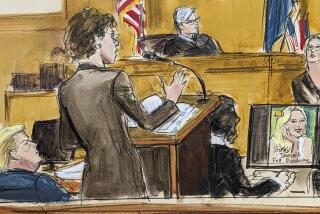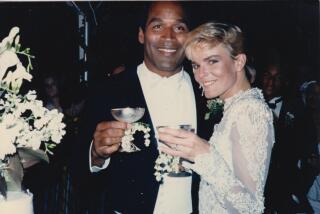Handling of Hair, Fibers Detailed at Simpson Trial : Courts: Prosecutors try to head off challenges over evidence examination. Glove measurements described.
Turning to the final body of physical evidence in the murder trial of O.J. Simpson, prosecutors Tuesday presented hairs and fibers that they contend tie Simpson to the scene of the killings he is charged with committing.
Although far less discriminating than the DNA test results that undergird the prosecution’s case, the so-called “trace evidence” helps sew together an interlocking web of clues that suggest Simpson had physical contact with the two murder victims, Nicole Brown Simpson and Ronald Lyle Goldman, whose slashed bodies were found by police just after 12 a.m. on June 12, 1994.
Two witnesses, both of them employees of the Los Angeles Police Department, described in great detail the steps taken to collect that evidence--testimony that often ground to a snail’s pace, drawing yawns from the judge, lawyers and defendant. In testimony Tuesday, the witnesses did not reveal the results of any tests performed on the hairs and fibers but hinted at some of the findings, expected to be described by a more experienced FBI witness.
Sources revealed last fall that a hair found on Goldman’s clothing had characteristics suggesting that it could have come from O.J. Simpson, a potentially valuable piece of prosecution evidence since Simpson did not know Goldman or have any known contact with him.
Simpson has pleaded not guilty to the murders.
Other hair and fiber evidence also is potentially incriminating, including hairs plucked from a glove discovered at Simpson’s estate. Some of those hairs, sources have long said, resemble hairs from the two victims. If so, that hair evidence would back up the DNA blood analysis, which revealed that blood with the genetic characteristics of Simpson and both victims was on that glove.
Those results are expected to be presented to the jury in the next day or so, but before letting jurors hear about them, Deputy Dist. Atty. Marcia Clark labored to head off the by-now predictable defense challenges, such as the allegation that evidence was mishandled or contaminated. Clark’s questioning was intentionally precise, but one effect was that the afternoon session dragged on in laborious descriptions of storage containers such as bindles and microscope slide materials such as “water mounts” and “permount” and the relative merits of each.
At one point, LAPD criminalist Susan Brockbank described how paper bindles were folded--in three, she said, comparing the effect to a burrito as opposed to a taco. She laughed apologetically at her own metaphor, but Superior Court Judge Lance A. Ito interjected: “We get the picture.”
That exchange elicited a few soft chuckles from the courtroom, and for the most part, defense attorneys appeared amused by the prolonged questioning on mundane evidence-collection issues. Simpson seemed to share his attorneys’ bemusement, arching his eyebrows as Clark asked: “What is permount?”
“It’s a mounting medium,” the witness replied.
Trying to Head Off Challenges
Stung early in the trial by defense allegations of evidence mishandling and tampering, prosecutors apparently are determined to cover every detail to head off defense challenges. On Tuesday, for instance, Clark guided Brockbank and another LAPD criminalist through detailed descriptions of evidence-handling and packaging--a subject that rarely even is contested in criminal trials, much less the subject of long-winded testimony.
Brockbank described more than a dozen times how she picked hairs and fibers of various items. Each time, she emphasized that she had worn clean gloves and worked over clean sheets of paper, which she said she used to collect fine pieces of fiber and debris.
Throughout her questioning, Clark subtly tried to suggest that evidence could not have been contaminated with hairs taken from Simpson, both by showing that much of the evidence had been analyzed before a sample of Simpson’s hair was taken and by showing that the examinations of other evidence were done in separate rooms from where the defendant’s hair sample was stored.
“Where was the defendant’s hair sample . . . at this time?” Clark asked.
“That was still in our property unit, the evidence-control unit,” Brockbank answered.
“And where was that in relation to where you were when you were collecting the hair and fiber from Ron Goldman’s shirt?” the prosecutor continued.
“It’s part of the lab complex, but the serology unit is a separate room within a large building,” the witness said, laughing nervously, as she did throughout the day. “You know, if you walked a fast pace, maybe a 30-second walk away or a minute walk away.”
Brockbank spent most of the day on the stand, usually describing her evidence-handling techniques with confidence but occasionally conceding that she had missed certain details.
When examining hairs from one of the gloves in the case, for instance, she counted seven. Later, when the same sample was analyzed by an FBI scientist, there were eight. Brockbank had testified that she used water to mount the hair samples on slides, a technique that does not allow the examiner to see the hairs clearly but that she said she used because her boss instructed her not to do anything that might affect the samples’ later usefulness in DNA testing.
Most importantly, she denied that the discrepancy was because of evidence-tampering.
“Did you add any hairs to the bindles after June 23?” Clark asked.
“No,” Brockbank answered, her voice betraying a slight hint of indignation.
Judge Seems Exasperated
Outside the courtroom, Simpson’s lead trial lawyer, Johnnie L. Cochran Jr., belittled the prosecution questioning, saying it had become lost in the minutiae.
“Seven hairs, eight hairs, who cares?” Cochran said, adding that the defense expected its cross-examination of Brockbank to be short. “We want to get on to the FBI guy.”
Superior Court Judge Lance A. Ito also seemed exasperated. Outside the jury’s presence, he bemoaned having to hear “about another change of gloves.”
“There are shortcuts to this, you know,” he said to Clark, who nodded and agreed to try to move more quickly.
When the jury returned for the late-afternoon session, Clark greeted them by saying: “Good evening.” She laughed, as did some members of the panel. “It feels like it’s 10 o’clock,” she chuckled softly.
Near the end of the day, Clark and the Simpson attorneys agreed to stipulate to a few facts regarding evidence-handling. Stipulations, in which both sides agree that a particular point is undisputed, have been rare in the case, and Tuesday’s appeared to speed the session slightly.
Mother Reacts to Photos
For their part, jurors did not seem particularly interested in Brockbank’s testimony, following it but taking fewer notes than they have with some of the case’s more energizing witnesses.
Earlier in the day, another LAPD criminalist, Denise Lewis, told jurors that the Simpson case marked her first time on the witness stand, but jurors nevertheless seemed to pay close attention to her careful testimony.
Likable and soft-spoken, Lewis delivered points for each side, explaining the care she took in handling evidence but then acknowledging under cross-examination that she could not vouch for the work of the coroner’s office, which sent the samples to the Police Department.
Among other things, Lewis described the clothes that Nicole Simpson was wearing on the night of the killings. When a picture of the short black cocktail dress was projected above the jury, the victim’s mother, sitting in the front row, brought her right hand to her face and cried into her palm.
Testimony continued uninterrupted as she silently wept, a friend’s arm draped around her.
Outside the courtroom, Juditha Brown embraced Simpson’s sister, another sign of the ties between the families that have persevered even through a trial that has put them on opposite sides of the question of Simpson’s guilt or innocence.
In the afternoon session, mindful of the emotional impact that the clothes have had on the families of the victims, Clark swiftly moved past a display of the blood-soaked garments. Seconds after they were displayed on the screen above the jury, she wheeled toward an associate and asked him to take them down. He did.
More Glove Testimony
Ever since prosecutors conducted an ill-advised glove demonstration earlier this month, barely a day goes by that the government attorneys do not attempt to undo whatever damage it might have caused to their case. On Tuesday, Clark asked Brockbank about her measurements of the gloves recovered from Simpson’s house and the crime scene--the same ones he struggled to put on in front of the jury.
Brockbank said the gloves were marked XL--for extra large--but that when she compared the lengths of the fingers to a new pair of extra-large gloves, the sizes were considerably different.
“They varied from finger to finger,” said Brockbank. “On a couple fingers of the right glove, there was an inch and a quarter difference.”
“Inch and a quarter,” Clark repeated, her emphasis clearly audible to jurors sitting just a few feet from the lectern where she was standing. “Hmmm.”
Testimony is scheduled to resume this morning with Brockbank back on the witness stand. In addition to her testimony, Ito has one niggling issue to resolve: Two jurors were reading John Grisham’s latest novel, “The Rainmaker,” which contains scathing passages about defense attorneys violating discovery rules and a running theme of domestic violence. Ito confiscated the books Monday, but still has not decided what to do with them.
On Tuesday, the judge handed attorneys for each side one-page summaries of the offending book. As he read the pages, Deputy Dist. Atty. Christopher A. Darden chuckled. “Looks like a good book,” he said with a smile.
When jurors returned from their break, Ito told them he had asked lawyers for both sides to consider what, if anything, to do about the reading material.
Once Brockbank finishes testifying, prosecutors will be nearly at the end of their case. One or two witnesses remain, though strategies have shifted rapidly and last-minute changes still are possible. If all goes as planned, prosecutors expect to rest their case either late this week or just after the July 4 holiday.
Times staff writer Jim Newton contributed to this article.
More to Read
Sign up for Essential California
The most important California stories and recommendations in your inbox every morning.
You may occasionally receive promotional content from the Los Angeles Times.









